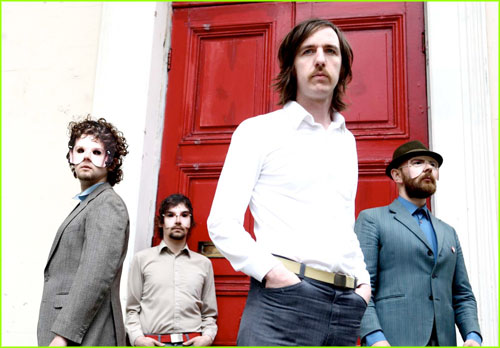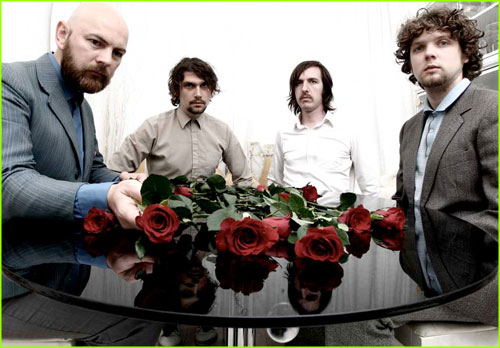
“Where’s my punk spirit / when I need it?” asks Wave Machines vocalist Tim Bruzon in the group’s anthemic single, “Punk Spirit” (watch the video HERE). Despite the song title, and despite the band’s British pedigree, there are no snarling vocals or thrashing guitars. It’s a straight-forward, beautiful tune stripped down to a soft guitar-riff and emotional melody. The real edge comes from the militaristic drumbeat that leads the track out.
Wave Machines is far from punk when to comes to defining the band’s debut album, Wave If You’re Really There. Most reviewers and music lovers categorize them as ‘electro-pop,’ which is accurate, given the fusion of classical instrumentation and programmed sounds. For every track like the heartfelt “Punk Spirit,” which is rooted in guitar and drums, there are songs like “Keep The Lights On” or “I Go I Go I Go” with digital flavor, dance-ready synths and disco-esque falsetto vocals.
Bassist James Walsh notes the man-versus-machine motif that serves as a centerpiece of the group’s sound.
“The theme of artificial stuff intersecting with natural stuff is a theme that runs through the music,” Walsh says. “We’ve got a lot of programmed beats in there with real instruments, the mixture of sounds, mixing up nature with stuff that humans invented.”
Overall, Wave If You’re Really There is an excellent, eclectic album that keeps things varied and interesting, track-by-track. The quartet — Walsh, Bruzon, Carl Brown, and Vidar Norheim — sprung around the Liverpool music scene, particularly one recording studio where Walsh was an engineer and had worked with one of Bruzon’s previous bands.
“I thought he was a very cool individual,” Walsh recalls. “When he and Carl got together and started writing songs, they ended up asking me to join, which was great because I had heard a lot of great stuff in the collaboration from the two of them.”
They discovered Vidar playing drums in a cover band. Impressed with not only his command of the drums but ability to play the vibraphone and MalletKAT as well, they invited him to come on-board. With the line-up solidified, the band took to a rehearsal space, writing songs until they had roughly ten “vibey and interesting” tracks ready to test on the road.
They bought a van, sought out promoters through MySpace and began playing around the UK — Walsh estimates they did about 70 gigs in 2007 — as a sort of edit session before recording, testing out the tunes and figuring out what was resonating with live audiences.
A show at the famed Chess Club party in London led to the release of their single, “I Go I Go I Go,” on the party’s accompanying label, Chess Club Records. Soon, Wave Machines found themselves with a manager, an agent, and a few festival gigs.

In 2008, the band hunkered down in St. Brides, an old church on the outskirts of the town center in Liverpool, to record Wave If You’re Really There. The space was inspiration for song parts and new sounds cooked up around various rooms in the empty building. A cupboard in the organ room served as a recording booth; the main room created the perfect space for Vidar to lay down drums.
“We’d wander around and do sneaky late-night bits of recording,” Walsh says. “We went to the main part of the church and got some really big lovely drum sounds in there, these massive lovely songs and sounds you struggle to get in a top recording studio.”
The church was also the site of the band’s notorious “Wave If You’re Really There” parties, a melding of visual art, poetry and live musical performances.
“We did four events where we hired a big sound system and spent a couple of days wrecking the inside of the church,” Walsh says with a laugh. “We had one guy make an 8-foot crucifix out of old TVs that were flashing on and off. We got another guy to take a quite spooky stairwell and project bits of the stairs onto other bits of the stairs, so it was really weird- looking. You couldn’t tell where the stairs were.”
The album takes its name from a 1950’s art installation that featured one of the first satellite TV link-ups between New York and L.A.
“People were walking by and seeing people walking by in the opposite city,” Walsh says.” This was done in the 1950’s when people didn’t know about these satellite link-ups. And they didn’t know if they were really real. There’s a really poignant shot of a guy holding up a placard saying ‘wave if you’re really there.’ ”
“There was this removal of humanity,” he continues. “but even with new technology, humanity really shines. We try to be positive in that sense, and show that there’s a good way of using technology.”
EXTRA CREDIT: Click here for the New Noise Archive!
